| Discourses | Biography | Portfolio |
This talk, delivered on 11/19/2024, was created for a creative writing poetry workshop, on how poetic form influences our personal stories. The topic, Radical Healing, was predetermined by Laura Lentz, Literati Academy‘s host.

The healing journey has many channels. Medical treatments originate outside of us; healing comes from within. I offer insight to into this topic from a spiritual perspective, as how the fundamental nature of healing is tethered to our return to the womb, and the recovery of wholeness, to the reclaiming of the unimpaired body in the hour after birth. The narrative of return offered is in a mosaic of song, poetry, quotations, lullabies, and healing practices, stitched together with the wisdom of Buddhist and Talmudic text. If you make time to listen to the associated music, you will fully experience the healing effect of the presentation.
Return to the Womb
Poet Theodore Roethke tells us, deep in their roots, all flowers keep the light. Here is that call for the return to the soul:
(3:29)
Return Again
Shlomo Carlebach
Return again, return again,
Return to the land of your soul.
Return to what you are.
Return to who you are.
Return to where you are
Born and reborn again.
Return again, return again,
Return to the land of your soul.
– Turning
We return to our seminal self, as we yield in humility, guided by this well crafted Shaker hymn, sung by Judy Collins:
(1:39)
Simple Gifts
Elder Joseph Brackett
‘Tis the gift to be simple, ’tis the gift to be free
‘Tis the gift to come down where we ought to be,
And when we find ourselves in the place just right,
‘Twill be in the valley of love and delight.
When true simplicity is gained,
To bow and to bend we shan’t be ashamed,
To turn, turn will be our delight,
Till by turning, turning we come ’round right.
– Befriend the Dark
Related: Embracing Darkness | Saved by the Dark | Carl Jung |
We enter into and befriend the dark with Maurya Simon’s The Gift, and Wendell Berry’s To Know the Dark:
The Gift
Maurya Simon
This darkness is a rope, not a prison:
hand over hand I haul myself in
to touch your face, to blossom.
My fingers crawl toward heaven
leaving behind whirling shadows;
this darkness is a rope, not a prison.
I follow light through forgotten
canyons and grottos;
I touch your face and I know
that even the sun has a mission:
as it climbs, it grows.
This darkness is a rope, not a prison
not a cell from which I hasten.
Freely, hand over hand I follow
to touch your face, to open and open
like a night-blooming jasmine,
or a well widening with echoes:
this darkness is a rope, not a prison,
I touch your face, I blossom.
To Know the Dark
Wendell Berry
To go in the dark with a light is to know the light.
To know the dark, go dark. Go without sight,
and find that the dark too, blooms and sings,
and is traveled by dark feet and dark wings.
Choreographer Judith Jamison recounts: The first time I started choreographing was in the dark, in my living room, with the lights completely out, to some popular music on the radio. I put the radio on full blast and I started moving. I didn’t know what it looked like. I didn’t want to see it. I had to start in the dark.
And now to Jesse Colin Young‘s compelling rendition of Darkness, Darkness, performed by Robert Plant:
(3:26)
Darkness, darkness, be my pillow
Take my head and let me sleep
In the coolness of your shadow
In the silence of your deep
Darkness, darkness, hide my yearning
For the things that I cannot be
Keep my mind from constant turning
Towards the things I cannot see now
The things I cannot see now
The things I cannot see
Darkness, darkness, long and lonesome
Ease the day that brings me pain
I have felt the edge of sadness
I have known the depth of fear
Darkness, darkness, be my blanket
Cover me with the endless night
Take away, take away the pain of knowing
Fill the emptiness of right now
Emptiness of right now, now, now
Emptiness of right now, now
Darkness darkness, be my pillow
Take my head and let me sleep
In the coolness of my shadow
In the silence of my dream
Darkness, darkness, be my blanket
Cover me with the endless night
Take away away the pain of knowing
Fill the emptiness of right now
Emptiness of right now now now
Emptiness of right
Oh yeah, oh yeah
Emptiness, emptiness
Oh yeah
– Lailah
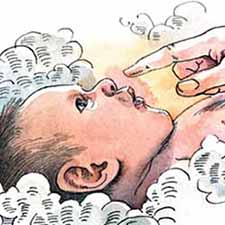
Once we’ve befriended the benevolent dark, we get to meet Lailah (Hebrew for night), the Angel of Conception.
In Rabbinic Judaism, Midrash is commentary that explains biblical texts; a passage (Tanhuma Pekudei 3), informs us that Lailah’s task is to light a lamp at the head of the fetus, enabling it to see the awaiting world from one end to the other, then whispers into the nurturing womb all of the world’s knowledge.
After completing this awe-inspiring task, Lailah does something dramatic and shockingly unexpected: upon the baby’s exit from the womb, she extinguishes the light, and presses her forefinger on its upper lip, causing it to forget everything–leaving an imprint, anatomically named the philtrum (the indentation in the middle of the upper lip).
If we accept the mystical notion that we are taught all there is in the womb, life after birth becomes a journey of recall; recall of Laihla’s teachings.
When we suddenly realize an answer, believe are born with a song, or wake up with an unexplainable insight, we experience an aha moment (Laihla will serenely smile if you gave her credit for these revelations). And perhaps, individuals who far surpass the limits of intelligence, such as those with savant syndrome (capable of recalling specific days of millennia), and others who set standards beyond comprehension, are by-products of a momentary interruption during Laihla’s erasure.
The original state inside the womb is limitless, and nothing prevents humans from diving back to mine the graveyard of the womb, for Lailah’s teachings.
The following is a prayer is for mothers who seek her blessings:
Angel Lailah, celestial being of conception and new beginnings,
I call upon you with a heart open to the divine potential within me.
Guide me as I embark on this new chapter of life,
whether it be a physical pregnancy, a creative endeavor, or a spiritual transformation.
Embrace my dreams and aspirations, and gently nurture them into reality.
Infuse me with your sacred energy,
so that I may manifest my highest good with grace and clarity.
Thank you for your loving presence and guidance.
Amen.”
Related: The Poetry of Home Birth | Prayer Before Birth | Return to the Womb |
– First Breath
 So, the newborn emerges from darkness into light with a gasp (and a cry), as its lungs allow blood to flow and collect oxygen. That first breath guides it to the next, marking the beginning of the conscious human journey.
So, the newborn emerges from darkness into light with a gasp (and a cry), as its lungs allow blood to flow and collect oxygen. That first breath guides it to the next, marking the beginning of the conscious human journey.
We don’t breathe in the future and we don’t breathe in the past; we’re always breathing in the present, which makes breath the perfect object of meditation; each is unique and happens just once.
In every breath cycle, the in-breath ushers an opportunity for rebirth. In meditation, we tune into this rise and fall. Each exhale allows us to let go, as we breathe into the silence our healing.
The following gatha, by Buddhist monk Thich Nhat Hanh, is crafted to return our attention to the present moment:
Breathing in, I know I am
breathing in.
Breathing out, I know I am
breathing out.
Breathing in, I notice my in-
breath has become deeper.
Breathing out, I notice that
my out-breath has become
slower. Breathing in, I
calm myself. Breathing out, I
feel at ease.
Breathing in, I smile.
Breathing out, I release.
Breathing in, I dwell in
the present moment.
Breathing out, I feel it is a
wonderful moment.
– The Golden Hour
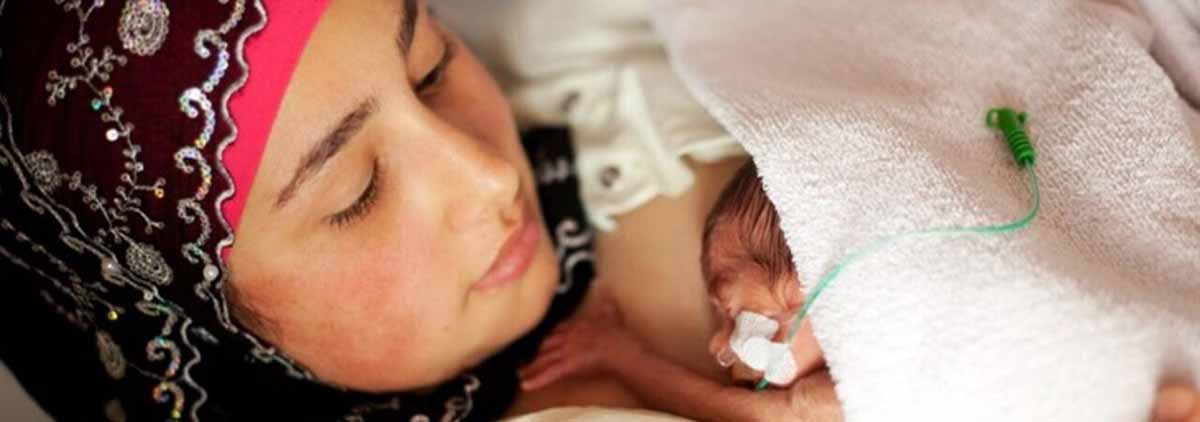
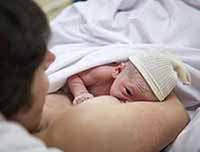 Once a newborn begins to breathe, it enters into the Golden Hour. This is when it is placed skin-to-skin on its mother’s stomach, and instinctively starts to crawl towards her breasts.
Once a newborn begins to breathe, it enters into the Golden Hour. This is when it is placed skin-to-skin on its mother’s stomach, and instinctively starts to crawl towards her breasts.
During this hour time stands still. It is an hour of postnatal bliss that creates a surge of oxytocin (the cuddle, or love hormone), in the mother.
Poet Gabriela Mistral speaks to this:
Like those jars that women put out to catch the dew of night,
I place my breasts before God. I give Him a new name, I call
Him the Filler, and I beg of Him the abundant liquid of life.
Thirstily looking for it, will come my son.
– Lullabies
In the womb, the fetus had been listening to Lailah but also to its mother’s voice. Research has shown that the baby will recognize it when she starts to sing. Lullabies are profoundly healing for both mother and baby. Singing to the newborn creates a spiritual union, as the mother is also singing to her unimpaired self.
I Get To Be The One
Lyrics by JJ Heller, sung by Jacqui Rivera
(3:10)
Well hello,
Little baby.
Your eyes have never seen the sun
You should know
Little baby
That I am the lucky one
I get to be the one to hold your hand
I get to be the one.
Through birthdays and broken bones
I’ll be there to watch you grow
I get to be the one.
Don’t feel alone now,
Little baby.
Do you hear me singing you a song
I can’t wait to show you
Little baby
How to crawl
How to walk
And how to run
I get to be the one to hold your hand
I get to be the one.
Through birthdays and broken bones
I’ll be there to watch you grow
I get to be the one.
How does someone so small
Hold my heart so tightly
I don’t even know you
I love you completely
I get to be the one to hold your hand
I get to be the one.
Through birthdays and broken bones
I’ll be there to watch you grow
I get to be the one to hold your hand
I get to be the one.
Through birthdays and broken bones
I’ll be there to watch you grow
I get to be the one.
– The Well in the Desert
 It is in the desert, the place of isolation we go to when we are wounded, that we can gain a deeper understanding of our authentic self and recalibrate our compass. In the solitude of illness, dreams, goals, and visions of the false self can be clearly seen–sometimes for the first time. It is a time when we can articulate a NO to who we are not, and YES to who we are. In the words of Antoine De Saint-Exupéry, what makes the desert beautiful is that it hides a well somewhere.
It is in the desert, the place of isolation we go to when we are wounded, that we can gain a deeper understanding of our authentic self and recalibrate our compass. In the solitude of illness, dreams, goals, and visions of the false self can be clearly seen–sometimes for the first time. It is a time when we can articulate a NO to who we are not, and YES to who we are. In the words of Antoine De Saint-Exupéry, what makes the desert beautiful is that it hides a well somewhere.
 In putting pen to paper, adopt the tenderness received from your caregiver, and redirect it to the injured self, or embrace the wounded child that has never experience it.
In putting pen to paper, adopt the tenderness received from your caregiver, and redirect it to the injured self, or embrace the wounded child that has never experience it.
Be not afraid to enter the pain, embrace your illness and own its limitations. Emotions, like children, heal when they are heard and validated. Poet Rolf Jacobsen, said, let the young rain of tears come, let the calm hands of grief come. It’s not all as evil as you think.
Thich Nhat Hanh adds, do not fight against pain; do not fight against irritation or jealousy, embrace them with great tenderness. Your anger is yourself, and you should not be violent toward it.
The founder of the Center for Mindfulness in Medicine, Jon Kabat-Zinn, also reminds us that healing is coming to terms with things as they are. That’s very different from curing. With curing, there is an expectation that things will be restored as they were before. And of course, who else can express gratitude better than Helen Keller? I thank God for my handicaps, for through them, I have found myself, my work and my God.
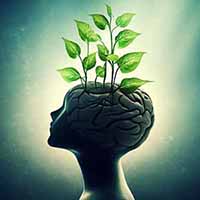 Here is E. E. Cummings’s expression affirming positive mind:
Here is E. E. Cummings’s expression affirming positive mind:
I thank you God for this most amazing day
for the leaping greenly spirits of trees
and a blue true dream of sky;
and for everything
which is natural
which is infinite
which is yes.
Poet Rainer Maria Rilke helps us to understand that perhaps all the dragons in our lives are princesses who are only waiting to see us act, just once, with beauty and courage. Perhaps everything that frightens us, is in its deepest essence, something helpless that needs our love.
Praise
Rainer Maria Rilke
Tell us, O poet, what do you do?—I praise
But those dark, deadly devastating ways,
How do you bear them, suffer them?—I praise.
And the Nameless, beyond guess or gaze,
How can you call it, conjure it?—I praise.
And whence your right, in every kind of maze
In every mask, to remain true?—I praise.
And that the mildest and the wildest ways
Know you like star and storm?—Because I praise.
The root of joy is gratitude; one cannot be grateful and sad at the same time. That’s why, Charlie Chaplin declared, no matter how desperate the predicament is, I am always very much in earnest about clutching my cane, straightening my derby hat and fixing my tie, even though I have just landed on my head.
Responses to Challenges
Now we meet 3 exceptional individuals who have dealt to the assault on their bodies, and how they responded to it:
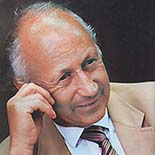 1. American journalist Norman Cousins, believed that each patient carries his own doctor inside him, a belief he maintained as he battled crippling tissue disease. Told that he had one chance in 500 of recovery, Cousins exposed himself to laughter brought on by the television show Candid Camera. He said, I made the joyous discovery that ten minutes of genuine belly laughter had an anesthetic effect and would give me at least two hours of pain-free sleep. When the pain-killing effect of the laughter wore off, I would switch on the motion picture projector again and it would lead to another pain-free interval. I have learned never to underestimate the capacity of the human mind and body to regenerate–even when prospects seem most wretched. The life force may be the least understood force on earth.
1. American journalist Norman Cousins, believed that each patient carries his own doctor inside him, a belief he maintained as he battled crippling tissue disease. Told that he had one chance in 500 of recovery, Cousins exposed himself to laughter brought on by the television show Candid Camera. He said, I made the joyous discovery that ten minutes of genuine belly laughter had an anesthetic effect and would give me at least two hours of pain-free sleep. When the pain-killing effect of the laughter wore off, I would switch on the motion picture projector again and it would lead to another pain-free interval. I have learned never to underestimate the capacity of the human mind and body to regenerate–even when prospects seem most wretched. The life force may be the least understood force on earth.
Cousins was also well aware that Not every illness can be overcome. But many people allow illness to disfigure their lives more than it should. They cave in needlessly. They ignore and weaken whatever powers they have for standing erect. There is always a margin within which life can be lived with meaning and even with a certain measure of joy, despite illness.
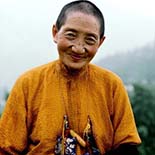 2. Tibetan Buddhist nun, Ani Pachen (Nun Big Courage), was 25 when she was imprisoned (for 21 years) for her refusal to denounce the Dalai Lama. She was beaten and hung by her wrists, spent a year in leg irons, and nine months in solitary confinement with no light: they put me in a hole in the ground and forced me to live in my own feces. In defiance, she recited the Purification Prayer, and completed her 100,000 purification prostrations within the confines of a 6’x9′ cell.
2. Tibetan Buddhist nun, Ani Pachen (Nun Big Courage), was 25 when she was imprisoned (for 21 years) for her refusal to denounce the Dalai Lama. She was beaten and hung by her wrists, spent a year in leg irons, and nine months in solitary confinement with no light: they put me in a hole in the ground and forced me to live in my own feces. In defiance, she recited the Purification Prayer, and completed her 100,000 purification prostrations within the confines of a 6’x9′ cell.
Buddhist Purification Prayer
Until I am enlightened, I take refuge
In the Buddha, Dharma and Sangha.
Through the merit I create by practicing giving and the other perfections
May I attain Buddhahood for the sake of all sentient beings.
A central Buddhist teaching is that all things are impermanent. Contemplating on impermanence becomes an antidote to suffering:
Impermanence
Patrul Rinpoche
Whatever is born is impermanent and is bound to die.
Whatever is stored up is impermanent and bound to run out.
Whatever comes together is impermanent and is bound to come apart.
Whatever is built is impermanent and bound to collapse.
Whatever rises up is impermanent and bound to fall down.
So, also, friendship and enmity, fortune and sorrow, good and evil, all the
thoughts that run through your mind—everything is always changing.
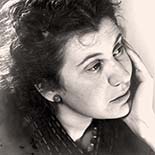 3. Dutch Jew, Etty Hillesum, was deported in 1943 and murdered in Auschwitz concentration camp. Less than 3 months before her murder, she threw a postcard with her final words out of a train, it read Opening the Bible at random I find this The Lord is my high tower. I am sitting on my rucksack in the middle of a full freight car. Father, Mother, and bother are a few cars away. In the end, the departure came without warning. We left the camp singing. Thank you for all your kindness and care.
3. Dutch Jew, Etty Hillesum, was deported in 1943 and murdered in Auschwitz concentration camp. Less than 3 months before her murder, she threw a postcard with her final words out of a train, it read Opening the Bible at random I find this The Lord is my high tower. I am sitting on my rucksack in the middle of a full freight car. Father, Mother, and bother are a few cars away. In the end, the departure came without warning. We left the camp singing. Thank you for all your kindness and care.
Ought we not, from time to time, open ourselves up to cosmic sadness? Give your sorrow all the space and shelter in yourself that is its due, for if everyone bears his grief honestly and courageously, the sorrow that now fills the world will abate. But if you do not clear a decent shelter for your sorrow, and instead reserve most of the space inside you for hatred and thoughts of revenge-from which new sorrows will be born for others-then sorrow will never cease in this world and will multiply.
At night, as I lay in the camp on my plank bed, I was sometimes filled with an infinite tenderness and I prayed, ‘Let me be the thinking heart of these barracks.’ That is what I want to be. The thinking heart of a whole concentration camp.
I never have the feeling that I have got to make the best of things; everything is fine just as it is. Every situation, however miserable, is complete in itself and contains the good as well as the bad. Those two months behind barbed wire have been the two richest and most intense months of my life, in which my highest values were so deeply confirmed.
– Visualization
An established method of tapping into our ideal state, is with the power of visualization, also known as conscious dreaming.
 What does visualization know of boundaries? By consciously visualizing transformations, humans mold their neural pathways towards desired goals: I saw the angel in the marble and carved until I set him free, Michelangelo. Twenty-three gold medalist Michael Phelps, rehearsed every detail, including the feel of the water and the sounds of the crowd, creating vivid mental pictures that empowered his performances.
What does visualization know of boundaries? By consciously visualizing transformations, humans mold their neural pathways towards desired goals: I saw the angel in the marble and carved until I set him free, Michelangelo. Twenty-three gold medalist Michael Phelps, rehearsed every detail, including the feel of the water and the sounds of the crowd, creating vivid mental pictures that empowered his performances.
My own practice, is to envision a multi-colored arrow glow and glide in the sky, piercing through every object I place in front of it, and I become that arrow.
– Poetry
We are Homo sapiens but also homo narrans–the storytelling animal. With poetry we tell, in sublime form, the return to our holy body, and as we gift our wounds to the reader, we are healed.
Poet Rudyard Kipling said, words are the most powerful drug used by mankind, and Jill Taylor, the brain scientist who suffered a massive brain stroke tells us, to experience peace does not mean that your life is always blissful. It means that you are capable of tapping into a blissful state of mind amidst the normal chaos of a hectic life.
– Conclusion
 We were not born to remain whole. We arrive to lose our leaves like the trees, the trees that are broken, and start again, drawing up from the great roots. I hear psychiatrist R. D. Laing telling us that the way out is through the door you came in.
We were not born to remain whole. We arrive to lose our leaves like the trees, the trees that are broken, and start again, drawing up from the great roots. I hear psychiatrist R. D. Laing telling us that the way out is through the door you came in.
Radical Healing isn’t so ‘radical’ after all. It is the reclaiming of the wholeness that existed in the hour after birth. In the womb, a physical umbilical attaches us to our mother. After we separate from the maternal body, there is another umbilicus that cannot be cut–the cord that connects us to the greater womb of creation; this is what we return to.
Difficult days offer ladders towards rebirth, and how we respond to brokenness is what defines our individual humanity. Out of the dark stone of suffering, compassion is born.
In composing poems:
– Befriend the dark. Benedictine nun, Joan Chittister, tells us that darkness deserves gratitude. It is the alleluia point at which we learn to understand that all growth does not take place in the sunlight. The spiritual task of life is to feed hope. Hope is not something to be found outside of us. It lies in the spiritual life we cultivate within. The whole purpose of wrestling with life is to be transformed into the self we are meant to become, to step out of the confines of our false securities and allow our creating God to go on creating, in us.
– Listen to the wisdom of your breath, it is where your true power and authority are found. Count your blessings. Don’t let illness define who you are, and as Poet Marge Piercy reminds us: hope sleeps in our bones like a bear waiting for spring to rise and walk.
– Compose (and sing) lullabies to your broken self. Remember that life is constantly providing new funds, new resources,  even when we are reduced to immobility. In life’s ledger there is no such thing as frozen assets. Do not lose sight that the darkest hour has only sixty minutes, so allow courage to guide your healing.
even when we are reduced to immobility. In life’s ledger there is no such thing as frozen assets. Do not lose sight that the darkest hour has only sixty minutes, so allow courage to guide your healing.
You’ll Never Walk Alone
Lyrics by Rodgers and Hammerstein
by Gerry & The Pacemakers
(3:23)
When you walk through the storm
Hold your head up high
And don’t be afraid of the dark
At the end of the storm
There’s a golden sky
And the sweet silver song of the lark
Walk on, through the wind
Walk on, through the rain
Though your dreams be tossed and blown
Walk on, walk on, with hope in your heart
And you’ll never walk alone
You’ll never walk alone
Walk on, walk on, with hope in your heart
And you’ll never walk alone
You’ll never walk alone
A student of Thich Nhat Hahn writes, Imagine for a moment that everything you see, hear, smell, touch, and taste is your very best friend. The spoon in your hand and the distant sound of traffic; the raindrops running down your back and the smell of dirty laundry; the blue sky and the flavor of cumin—these are not mere passing encounters with two-dimensional items. Instead, imagine for a moment that everything you are experiencing is your very, very best friend saying hello.
Radical Healing sits quietly on your lap, a faithful child–go ahead and tap into the medicine already within.
– What if…
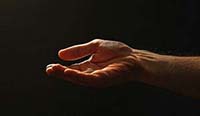 What if that illness is patiently waiting for you to unmask it?
What if that illness is patiently waiting for you to unmask it?
What if you allowed yourself to re-emerge from the womb and retake that first breath? Resurrection is everyone’s birthright.
Now imagine, further, that uncertainty and fear are sitting next to you. What would you say to them?
I conclude this presentation with my answer to that question:
Come Here, Fear
Abraham Menashe
Come here, fear,
come out of the dark.
Sit next to me—
it’s okay, you’re safe.
Tell me, has anyone listened to your story?
Has anyone gazed
Into your stony eyes—
Rubbed your hunched back?
Here is a blanket
for your cold bones,
Bread for your stomach,
and tea for your nerves.
I promise to listen,
to your amazing story!
In Pharaoh’s reign, your heart
was hardened, over and over…
Come closer, fear
Here’s my hand—
please touch it
Come near,
I want to know you.
Come here, fear,
I want you to know me.